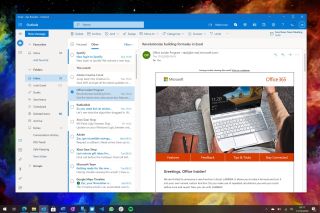In May of 2022, Microsoft finally announced the beta for the new version of Outlook that has been in development for a few years now. This app had already been leaked, but this was the first time we got to see demonstrations of the new features. Any business using Microsoft 365 will know about Outlook. It is a crucial service for many – TechQuarters, who provide IT support services London organisations have been using for over a decade, have helped many businesses adopt Outlook, to great success.
Those who use Outlook for business will probably have noticed that there are two versions of the service: Outlook on desktop, and Outlook.com. The two versions of the service have considerably different user interfaces. A lot of people only use Outlook.com (such as people who only use it for personal emails), but anyone that goes form Outlook.com to Outlook desktop may be surprised by how different it looks. The initial impressions of Outlook One, from those who were able to see or access it, was that the new app will be much more like Outlook.com than its predecessor.
Outlook One
While Outlook One is not yet available to consumers, those with school or work accounts who are signed up for the Windows Insider program have been able to test it out. Based on these user’s accounts, it seems as though Microsoft are putting a fair amount of focus on bringing together the user interface of the web app and the desktop app so that they are seamless – as for a long time, the UI of the two versions of the service have been considerably different. But there are a number of other new features that are worth getting excited about:
Loop Integration: This new system from Microsoft is designed for making collaboration within teams more fluid, with lower latency. With Loop, you can create, share, and copy components (such as task lists, pools, etc) to colleagues across different apps in Microsoft 365. The idea is that these Loop components will remain in sync in real-time. Microsoft have already released images demonstrating the use of Loop components within an email thread in Outlook One.
@files / @documents: Most people who use Outlook will be familiar with the @mention function – by typing ‘@’ followed by the name of a contact, you can instantly tag them in an email. Now, you can do the same thing with @files and @documents. Simply type ‘@’ and the name of the file and it will be attached within the text of your email. This new way of attaching files seems infinitely quicker than the current method that requires navigating the ribbon.
Calendar & To-Do Integration: Microsoft To-Do is a highly useful product in Microsoft 365, and it is being integrated into Outlook One. In the future, users will be able to review their emails and quickly create to-do tasks based on information from their emails – Microsoft have published images that demonstrate a user dragging and dropping an email into a To-Do panel in Outlook One, thus instantly creating a task from that email. The same can be done by dragging and dropping an email into your Calendar, in order to create an event.New Launcher: With the current version of Outlook, you have the different core capabilities of the app – mail, contacts, calendar, tasks – and to switch between them, you have a little menu situated below your inbox. With Outlook One, a new launch menu has been integrated along the left-hand side of the app window.
This launcher makes it easier to switch between mail and calendar, for example, and you can also pin other Microsoft 365 apps to the launcher – such as Word, Excel, To-Do, etc. – so that you can easily launch them when you need to.
To become microsoft certified azure data engineer associate you must visit here















